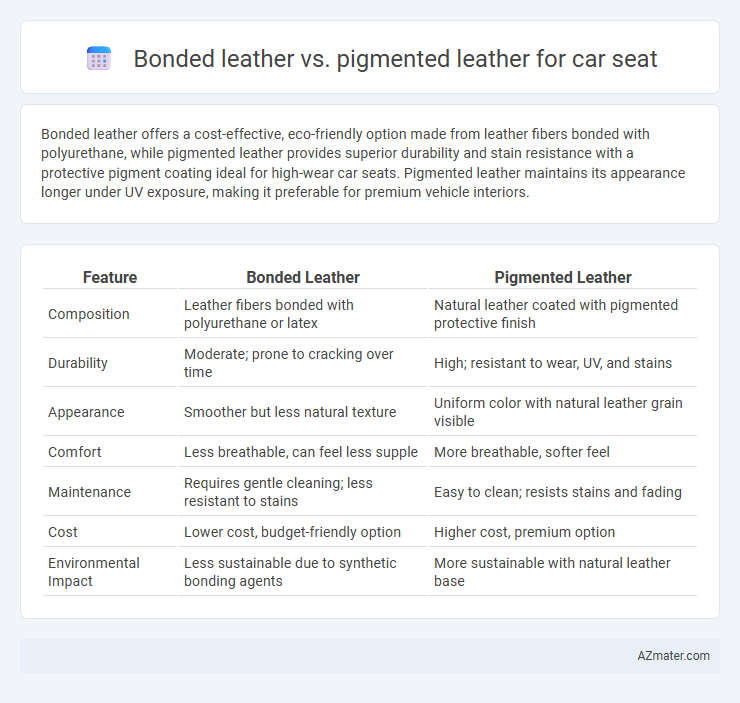Bonded leather offers a cost-effective, eco-friendly option made from leather fibers bonded with polyurethane, while pigmented leather provides superior durability and stain resistance with a protective pigment coating ideal for high-wear car seats. Pigmented leather maintains its appearance longer under UV exposure, making it preferable for premium vehicle interiors.
Table of Comparison
| Feature | Bonded Leather | Pigmented Leather |
|---|---|---|
| Composition | Leather fibers bonded with polyurethane or latex | Natural leather coated with pigmented protective finish |
| Durability | Moderate; prone to cracking over time | High; resistant to wear, UV, and stains |
| Appearance | Smoother but less natural texture | Uniform color with natural leather grain visible |
| Comfort | Less breathable, can feel less supple | More breathable, softer feel |
| Maintenance | Requires gentle cleaning; less resistant to stains | Easy to clean; resists stains and fading |
| Cost | Lower cost, budget-friendly option | Higher cost, premium option |
| Environmental Impact | Less sustainable due to synthetic bonding agents | More sustainable with natural leather base |
Introduction to Bonded and Pigmented Leather for Car Seats
Bonded leather for car seats consists of leather scraps and fibers bonded together with polyurethane or latex, offering a cost-effective and eco-friendly alternative to genuine leather. Pigmented leather features a protective polymer coating that enhances durability and resistance to stains and fading, making it ideal for high-traffic automotive interiors. Both materials balance aesthetics and functionality, with bonded leather providing affordability and pigmented leather delivering superior wear resistance.
What is Bonded Leather?
Bonded leather for car seats is a material made from shredded leather fibers combined with a polyurethane or latex backing, offering a cost-effective alternative to genuine leather. It provides a uniform appearance and can mimic the look and feel of pigmented leather, although it typically lacks the durability and breathability of full-grain or pigmented leather. Bonded leather is often used in budget-friendly car interiors, balancing aesthetic appeal with economic considerations.
What is Pigmented Leather?
Pigmented leather for car seats is coated with a durable polymer layer that provides enhanced protection against wear, UV rays, and stains, making it ideal for high-traffic automotive interiors. This type of leather retains a consistent color and texture due to the pigmented finish, ensuring long-lasting aesthetic appeal and easier maintenance compared to untreated leather surfaces. Unlike bonded leather, which is made from shredded leather fibers bonded with polyurethane or latex, pigmented leather consists of genuine leather with a protective pigment topcoat that preserves its strength and durability.
Durability: Bonded vs Pigmented Leather
Pigmented leather offers superior durability for car seats due to its protective surface coating that resists scratches, UV rays, and stains, maintaining appearance over time. Bonded leather, composed of leather fibers bonded with polyurethane or latex, is less durable and prone to peeling and cracking under heavy use or exposure to sunlight. For long-lasting car seat upholstery, pigmented leather provides greater resistance to wear and environmental damage compared to bonded leather.
Comfort and Feel Comparison
Bonded leather offers a smoother surface with a firmer feel due to its synthetic layers fused with leather fibers, resulting in less breathability and increased heat retention during long drives. Pigmented leather features a protective polyurethane coating, providing enhanced durability and a slightly stiffer texture while maintaining natural leather's breathability and temperature regulation. For car seat comfort, pigmented leather is generally preferred for its balance between softness, breathability, and resistance to wear, whereas bonded leather prioritizes affordability with a less luxurious tactile experience.
Aesthetic Appeal: Visual Differences
Bonded leather offers a uniform, smooth surface with consistent color but may lack the natural grain and texture seen in pigmented leather. Pigmented leather retains the leather's original grain and texture beneath a durable pigment coating, providing a more authentic and luxurious look. The visual appeal of pigmented leather often includes subtle imperfections and natural markings, enhancing the premium feel in car seat interiors.
Maintenance and Cleaning Requirements
Bonded leather car seats require gentle cleaning with mild soap and water to avoid damaging the composite fibers, as harsh chemicals can cause peeling or cracking. Pigmented leather offers a more durable, protective surface that resists stains and fading, allowing for easier maintenance with regular wiping and conditioning using leather-specific products. Both materials benefit from immediate attention to spills, but pigmented leather generally demands less frequent deep cleaning compared to bonded leather.
Cost Differences and Value for Money
Bonded leather car seats generally cost less than pigmented leather due to lower production expenses, making them a budget-friendly option; however, pigmented leather offers superior durability and resistance to wear, providing better long-term value for money. While bonded leather consists of leather scraps bonded with polyurethane, leading to a less natural feel and shorter lifespan, pigmented leather's protective coating ensures easier maintenance and maintains appearance over time. For consumers comparing initial cost versus longevity, pigmented leather often represents a smarter investment despite the higher upfront price.
Environmental Impact and Sustainability
Bonded leather, made from shredded leather scraps combined with synthetic materials, often involves high energy consumption and limited recyclability, contributing to environmental concerns. Pigmented leather, coated with a durable polymer layer, offers greater longevity and resistance to wear, reducing the need for frequent replacement and lowering overall resource use. Sustainable car seat options favor pigmented leather due to its extended lifespan and better potential for eco-friendly treatment compared to the chemically-intensive production of bonded leather.
Which Leather Type is Best for Car Seats?
Pigmented leather offers superior durability and resistance to stains, making it ideal for car seats exposed to heavy use and varying weather conditions. Bonded leather, composed of leather scraps bonded with polyurethane, tends to wear faster and lacks the breathability and longevity of pigmented leather. For car seats, pigmented leather is the best choice due to its enhanced protection, longer lifespan, and easier maintenance.

Infographic: Bonded leather vs Pigmented leather for Car seat
 azmater.com
azmater.com